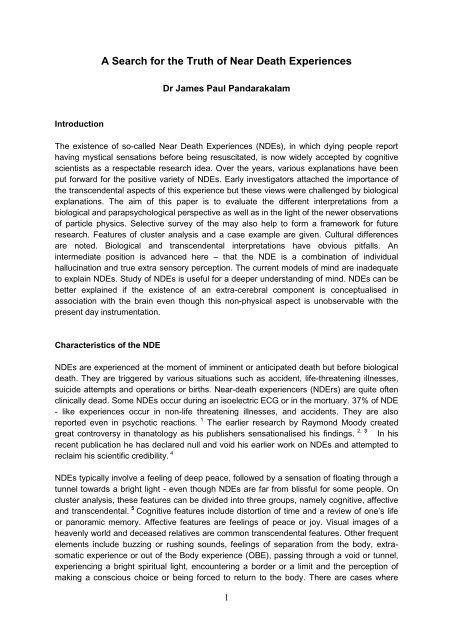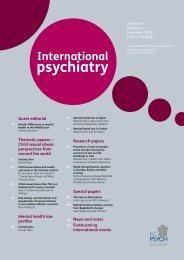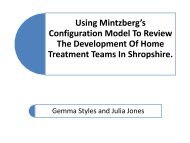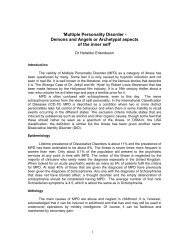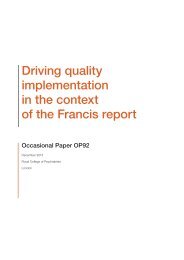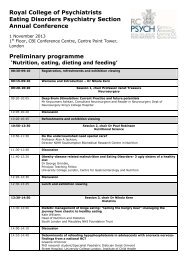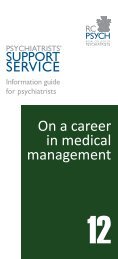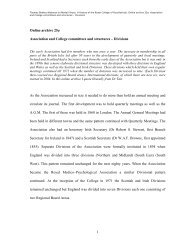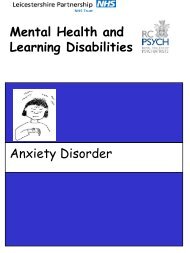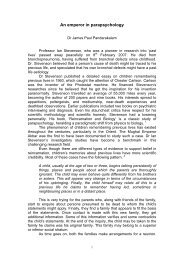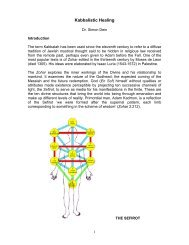A Search for the Truth of Near Death Experiences
A Search for the Truth of Near Death Experiences
A Search for the Truth of Near Death Experiences
Create successful ePaper yourself
Turn your PDF publications into a flip-book with our unique Google optimized e-Paper software.
A <strong>Search</strong> <strong>for</strong> <strong>the</strong> <strong>Truth</strong> <strong>of</strong> <strong>Near</strong> <strong>Death</strong> <strong>Experiences</strong><br />
Dr James Paul Pandarakalam<br />
Introduction<br />
The existence <strong>of</strong> so-called <strong>Near</strong> <strong>Death</strong> <strong>Experiences</strong> (NDEs), in which dying people report<br />
having mystical sensations be<strong>for</strong>e being resuscitated, is now widely accepted by cognitive<br />
scientists as a respectable research idea. Over <strong>the</strong> years, various explanations have been<br />
put <strong>for</strong>ward <strong>for</strong> <strong>the</strong> positive variety <strong>of</strong> NDEs. Early investigators attached <strong>the</strong> importance <strong>of</strong><br />
<strong>the</strong> transcendental aspects <strong>of</strong> this experience but <strong>the</strong>se views were challenged by biological<br />
explanations. The aim <strong>of</strong> this paper is to evaluate <strong>the</strong> different interpretations from a<br />
biological and parapsychological perspective as well as in <strong>the</strong> light <strong>of</strong> <strong>the</strong> newer observations<br />
<strong>of</strong> particle physics. Selective survey <strong>of</strong> <strong>the</strong> may also help to <strong>for</strong>m a framework <strong>for</strong> future<br />
research. Features <strong>of</strong> cluster analysis and a case example are given. Cultural differences<br />
are noted. Biological and transcendental interpretations have obvious pitfalls. An<br />
intermediate position is advanced here – that <strong>the</strong> NDE is a combination <strong>of</strong> individual<br />
hallucination and true extra sensory perception. The current models <strong>of</strong> mind are inadequate<br />
to explain NDEs. Study <strong>of</strong> NDEs is useful <strong>for</strong> a deeper understanding <strong>of</strong> mind. NDEs can be<br />
better explained if <strong>the</strong> existence <strong>of</strong> an extra-cerebral component is conceptualised in<br />
association with <strong>the</strong> brain even though this non-physical aspect is unobservable with <strong>the</strong><br />
present day instrumentation.<br />
Characteristics <strong>of</strong> <strong>the</strong> NDE<br />
NDEs are experienced at <strong>the</strong> moment <strong>of</strong> imminent or anticipated death but be<strong>for</strong>e biological<br />
death. They are triggered by various situations such as accident, life-threatening illnesses,<br />
suicide attempts and operations or births. <strong>Near</strong>-death experiencers (NDErs) are quite <strong>of</strong>ten<br />
clinically dead. Some NDEs occur during an isoelectric ECG or in <strong>the</strong> mortuary. 37% <strong>of</strong> NDE<br />
- like experiences occur in non-life threatening illnesses, and accidents. They are also<br />
reported even in psychotic reactions. 1 The earlier research by Raymond Moody created<br />
great controversy in thanatology as his publishers sensationalised his findings. 2, 3 In his<br />
recent publication he has declared null and void his earlier work on NDEs and attempted to<br />
reclaim his scientific credibility. 4<br />
NDEs typically involve a feeling <strong>of</strong> deep peace, followed by a sensation <strong>of</strong> floating through a<br />
tunnel towards a bright light - even though NDEs are far from blissful <strong>for</strong> some people. On<br />
cluster analysis, <strong>the</strong>se features can be divided into three groups, namely cognitive, affective<br />
and transcendental. 5 Cognitive features include distortion <strong>of</strong> time and a review <strong>of</strong> one’s life<br />
or panoramic memory. Affective features are feelings <strong>of</strong> peace or joy. Visual images <strong>of</strong> a<br />
heavenly world and deceased relatives are common transcendental features. O<strong>the</strong>r frequent<br />
elements include buzzing or rushing sounds, feelings <strong>of</strong> separation from <strong>the</strong> body, extrasomatic<br />
experience or out <strong>of</strong> <strong>the</strong> Body experience (OBE), passing through a void or tunnel,<br />
experiencing a bright spiritual light, encountering a border or a limit and <strong>the</strong> perception <strong>of</strong><br />
making a conscious choice or being <strong>for</strong>ced to return to <strong>the</strong> body. There are cases where<br />
1
OBE involve externally verifiable in<strong>for</strong>mation. 6 After <strong>the</strong> NDE, <strong>the</strong> subjects generally keep<br />
quiet about <strong>the</strong>ir experience; <strong>the</strong>y talk about it only in appropriate situations. 30% <strong>of</strong> NDErs<br />
<strong>for</strong>get <strong>the</strong> experience because <strong>of</strong> <strong>the</strong> dream-like and dissociative nature <strong>of</strong> <strong>the</strong> experience,<br />
and <strong>the</strong> involvement <strong>of</strong> <strong>the</strong> amnesia-prone temporal lobe. Some remember it only under<br />
hypnosis.<br />
NDErs can experience a reverse cultural shock, undergoing a revolution <strong>of</strong> values and<br />
opinions. They develop decreased fear <strong>of</strong> death and increased conviction <strong>of</strong> after-death<br />
existence. Non-religious people may become religious or spiritually oriented. They develop<br />
more sense <strong>of</strong> responsibility and give more importance to acquiring knowledge. There are<br />
psycho-hygienic effects and NDErs have less suicidal inclinations. All true NDErs cherish<br />
nostalgia <strong>for</strong> <strong>the</strong> experience and find a com<strong>for</strong>t in it in tough times.<br />
Michael Sabom, using a Life Changes Questionnaire and <strong>the</strong> previously developed Religious<br />
Motivation Scale, found significant differences between <strong>the</strong> patients who had had an NDE<br />
and who had not. 7 The life changes noted included enhanced faith in a supreme power,<br />
sanctity <strong>of</strong> life and a desire <strong>for</strong> positive human engagement. However, up to a quarter <strong>of</strong><br />
NDEs are negative. Experiencers <strong>of</strong> negative NDE also report an OBE and a dark transition<br />
zone, but accompanied by unpleasant feelings <strong>of</strong> fear or panic. They describe encountering<br />
bad <strong>for</strong>ces or beings, and entering a hellish environment. But negative NDEs also have a<br />
positive life changing effect. Unsurprisingly, negative NDEs are more suppressed than<br />
positive NDEs.<br />
A Case <strong>of</strong> NDE or NDE-like experience<br />
The following account <strong>of</strong> an NDE from my own case file has some <strong>of</strong> <strong>the</strong> ingredients <strong>of</strong> an<br />
NDE, even though <strong>the</strong>re is no evidence to suggest that <strong>the</strong> subject had a somatic death but<br />
was in a physiological crisis. It is not a classic case <strong>of</strong> NDE and I am quoting this case to<br />
illustrate that some <strong>of</strong> <strong>the</strong> reported cases <strong>of</strong> NDE are very similar to normal experiences in<br />
physiological crisis.<br />
‘I am now an old aged pensioner (aged 77), but over past years have had occasions<br />
<strong>of</strong> being rushed into hospital, more than once on a 50/50 chance <strong>of</strong> survival. I would<br />
like to relate <strong>of</strong> one such occasion in particular, where I could say, ‘Yes I did have a<br />
brush with death, but my experience was so vivid and real, I was totally convinced I<br />
had died and returned’. Starting from when <strong>the</strong> anaes<strong>the</strong>tist put <strong>the</strong> needle in <strong>the</strong><br />
back <strong>of</strong> my hand. ‘Just a little prick’, he said, and counted up to ten. I remember 7 or<br />
8. My head seemed to leave me empty – a loud buzzing, <strong>the</strong>n a rushing noise and<br />
sound as I went into a dark tunnel. It was like being in an express train, but not<br />
literally, as I didn’t seem to be enclosed and I could see far ahead and notice <strong>the</strong><br />
open light at <strong>the</strong> end <strong>of</strong> <strong>the</strong> tunnel approaching nearer and nearer all <strong>the</strong> time,<br />
although it seemed endless in matter <strong>of</strong> time. On leaving <strong>the</strong> ‘tunnel’, my first<br />
impression was that I was in Heaven. But oh dear, it was nothing that I was ever led<br />
to believe from all <strong>the</strong> beliefs and stories. It was so totally unexpected and out <strong>of</strong><br />
character. The ‘beyond’ was so flat and massive, no end in sight! No hills or mounds,<br />
no buildings <strong>of</strong> any nature. No trees or gardens <strong>of</strong> so called roses, yet it was so<br />
tranquil beautiful. No signs or even a hint <strong>of</strong> what we have on earth planet. You first<br />
2
step out into space. There is not even ground or earth to walk on; you first float along<br />
as a bird would fly. Visions <strong>of</strong> people were <strong>the</strong>re like a vast community, but <strong>the</strong>re was<br />
nothing to touch <strong>the</strong>y had no material body but masses <strong>of</strong> colour about <strong>the</strong>ir spiritual<br />
entity. Each one wore a single long garment in <strong>the</strong> palest <strong>of</strong> blues, greens, yellows<br />
and purple - <strong>the</strong>re appeared no black or white or even red but all o<strong>the</strong>r shades <strong>of</strong><br />
colour. One couldn’t describe <strong>the</strong> garments as <strong>the</strong>y are not manufactured. Just<br />
apparitions swa<strong>the</strong>d in mist like – appearances. They just floated around, like walking<br />
on a cloud. There was a delightful scent and odour in <strong>the</strong> air about <strong>the</strong>m but place<br />
was very calm and peaceful, I felt totally relaxed and happy. I was at rest within<br />
myself. Time seemed non-existent. I wanted to stay <strong>the</strong>re, disappointed only because<br />
I cannot recollect seeing or meeting any <strong>of</strong> my family, friends or acquaintances, as on<br />
earth. I sincerely did believe <strong>the</strong>y lived on <strong>the</strong> o<strong>the</strong>r side along with our individual and<br />
spiritual guides. However I was drawn back to <strong>the</strong> tunnel, stepped in, and entered. All<br />
<strong>the</strong> emptiness within me seemed to disappear. I had enjoyed <strong>the</strong> feeling <strong>of</strong> love and<br />
peace and now I was experiencing a sense <strong>of</strong> life coming back into my body, but<br />
could do nothing myself. There were no thoughts, just unexplainable senses that I<br />
was aware <strong>of</strong>. I just floated along again, but had <strong>the</strong> strange knowledge that I was not<br />
on a level, as I seemed to be flying higher and higher upwards - it didn’t seem at all<br />
like <strong>the</strong> tunnel I had previously gone down. As I came out <strong>of</strong> <strong>the</strong> end <strong>of</strong> <strong>the</strong> tunnel, I<br />
had <strong>the</strong> awareness <strong>of</strong> something or someone gently smacking my face, <strong>the</strong>n heard<br />
my name being called out, and on opening my eyes, <strong>the</strong> light was overpowering and I<br />
wanted to close <strong>the</strong>m again, but once more I was smacked a little more roughly and<br />
harder and heard <strong>the</strong> words ‘Come on Mr L -, can you hear me?’ Suddenly I realised<br />
that I had entered my own physical body! I was back in my hospital bed, alive and<br />
back in my ward, and realised or thought it had all been a dream. I have never<br />
<strong>for</strong>gotten that experience and yes, I would say I ‘passed over’ or had my brush with<br />
death but was allowed to return to life and my realities again. But I shall never be<br />
afraid <strong>of</strong> death again; <strong>the</strong>re is nothing to be frightened <strong>of</strong> anymore’.<br />
Interpretations <strong>of</strong> NDEs<br />
Even after a quarter <strong>of</strong> a century <strong>of</strong> research into NDE phenomena, <strong>the</strong>re is no consensus <strong>of</strong><br />
opinion among <strong>the</strong> scientific community with regard to its interpretation. There are organic,<br />
pharmacological, physiological, neurological psychological, socio-cultural, paranormal and<br />
spiritual explanations. Ernest Rodin (1980) considered NDE as a final psychosis where <strong>the</strong><br />
dying individual acts as his own judge, jury, accuser, prosecutor, defence attorney and<br />
witness. 8 He or she alone renders <strong>the</strong> final verdict <strong>of</strong> guilty or not guilty. According to <strong>the</strong><br />
pharmacological view, NDEs are <strong>the</strong> products <strong>of</strong> <strong>the</strong> drugs administered during <strong>the</strong> illness.<br />
9,10,11 However, <strong>the</strong>re are NDE cases in cultures where no advanced modern treatment is<br />
available. In India, where patients are looked after at home, <strong>the</strong>re are full-blown cases <strong>of</strong><br />
NDE. It is argued that psychotropic drugs only interfere with <strong>the</strong> perception <strong>of</strong> NDE and block<br />
<strong>the</strong> memories. The physiological view is that NDE is due to <strong>the</strong> cessation <strong>of</strong> oxygen to <strong>the</strong><br />
brain during <strong>the</strong> clinical death and represents <strong>the</strong> last compensatory gasp <strong>of</strong> <strong>the</strong> dying brain.<br />
12,13<br />
CO 2 accumulation is said to explain <strong>the</strong> tunnel experience but that does not explain <strong>the</strong><br />
life review and <strong>the</strong> Light Beings. NDEs have also taken place when <strong>the</strong> measured oxygen<br />
level was well above <strong>the</strong> average level. While <strong>the</strong> possible physiological mechanism<br />
3
underlying NDEs have been speculated upon, <strong>the</strong>re is no research demonstrating <strong>the</strong> actual<br />
physiological conditions associated with NDEs. 14,15,16<br />
According to <strong>the</strong> biochemical view hallucinatory neurotransmitters and endorphins are<br />
thought to be responsible <strong>for</strong> NDEs. 17,18 So far, no NDE specific transmitter constellations<br />
have been detected. Stress-induced limbic lobe dysfunction is a neurological explanation. 14<br />
Ano<strong>the</strong>r neurological view is that <strong>the</strong> ‘NDE is similar to <strong>the</strong> autoscopic hallucination. 19 In <strong>the</strong><br />
OBE, <strong>the</strong> centre <strong>of</strong> thinking is in <strong>the</strong> ‘second body’ and in <strong>the</strong> case <strong>of</strong> autoscopic<br />
hallucination <strong>the</strong> centre <strong>of</strong> thinking is still in <strong>the</strong> physical body. Electrical stimulation <strong>of</strong> <strong>the</strong><br />
temporal lobe has produced NDE-like experiences. However, visual hallucinations in this<br />
situation as well as in temporal lobe epilepsy are mere visual disturbances and not intact<br />
visual images as in NDE perceptions. The NDE has also been hypo<strong>the</strong>sised to be a<br />
protective mechanism to conserve energy and provide necessary brain stimuli. 20<br />
Hart (1954) identified 288 published cases in which a person claimed to have perceived<br />
events at some distant location while in <strong>the</strong> extra-somatic state. 21 It is also worth mentioning<br />
that OBE have been reported to occur in healthy individuals and under experimental<br />
conditions. 22,23,24,25 Depersonalisation syndrome occurring at <strong>the</strong> time <strong>of</strong> life threatening<br />
danger was ano<strong>the</strong>r speculation. 26 Psychologists have postulated that NDEs are <strong>the</strong> product<br />
<strong>of</strong> mental defence mechanisms – denial, dissociation, wish fulfilment, regression and<br />
projection. Yet in <strong>the</strong> NDE, <strong>the</strong> subject is not escaping from <strong>the</strong> situation; he is frequently<br />
witnessing <strong>the</strong> scene <strong>of</strong> resuscitation. NDEs have common elements and are independent <strong>of</strong><br />
<strong>the</strong> belief system. Even when patients are sure to recover, <strong>the</strong>y may still experience an NDE.<br />
The replay <strong>of</strong> birth experience has been a popular psychological explanation. 27 Regression<br />
is used to explain <strong>the</strong> mystical elements (regression to a state be<strong>for</strong>e ego differentiation). But<br />
again, <strong>the</strong> NDE is experienced with an integrated ego identity.<br />
The tunnel experience is compared to <strong>the</strong> birth canal experience. New-born children have<br />
very poor perception <strong>of</strong> objects. But NDEers have full perception <strong>of</strong> objects. Nei<strong>the</strong>r is <strong>the</strong><br />
birth experience a ‘positive’ one. People who had Caesarean births also have had NDEs.<br />
Tunnel experiences are reported to occur with hallucinogenic drugs, hypnogogic and ecstatic<br />
states, argued to be <strong>the</strong> result <strong>of</strong> over activity <strong>of</strong> <strong>the</strong> visual cortex and not announcing<br />
proximity <strong>of</strong> death. The collective unconscious and <strong>the</strong> archetypes are used to explain NDE.<br />
However, OBEs cannot be explained according to Jungian <strong>the</strong>ories. Finally, NDEs have<br />
been compared to o<strong>the</strong>r mental reactions to perceived threat, coloured by culture and<br />
current stress. 28<br />
None <strong>of</strong> <strong>the</strong> organic and psychological <strong>the</strong>ories explain <strong>the</strong> externally verifiable in<strong>for</strong>mation<br />
<strong>the</strong> subjects give after <strong>the</strong> bodily separation. How can some persons who are ostensibly<br />
unconscious, if not dead, never<strong>the</strong>less perceive <strong>the</strong>ir bodies from above, and sometimes<br />
become aware <strong>of</strong> events occurring outside <strong>the</strong> reach <strong>of</strong> <strong>the</strong>ir ordinary senses? The biological<br />
interpretations do not adequately explain <strong>the</strong> enhanced cognitive abilities <strong>of</strong> <strong>the</strong> NDErs. 29<br />
Parapsychologists believe that enhanced cognitive abilities when <strong>the</strong> brain is underactive<br />
point towards a true involvement <strong>of</strong> extra sensory perception (telepathy, clairvoyance,<br />
precognition). Philosophically oriented investigators think that NDE points towards an<br />
intrinsic spiritual reality. They attach even transcendental importance to <strong>the</strong> reports <strong>of</strong> Light<br />
Beings, making it a symbol <strong>of</strong> modern mysticism outside <strong>the</strong> religious field. 30 Peter Fenwick’s<br />
recent studies have revealed several features <strong>of</strong> NDE that do not con<strong>for</strong>m to <strong>the</strong> usual<br />
4
eductionist view. 31 He states that NDE can occur when a person is unconscious, which<br />
suggests that NDEs may not be purely subjective because in <strong>the</strong> state <strong>of</strong> unconsciousness,<br />
<strong>the</strong> modules <strong>of</strong> <strong>the</strong> brain responsible <strong>for</strong> <strong>the</strong> construction <strong>of</strong> <strong>the</strong> world are <strong>of</strong>f-line. There are<br />
cognitive scientists who hold <strong>the</strong> view that NDEs are symptoms <strong>of</strong> dissociative states or<br />
post-traumatic stress disorder. But Bruce Greyson’s studies suggest that <strong>the</strong> NDEr’s stress<br />
response is a normal reaction to an anomalous expression ra<strong>the</strong>r than a psychopathological<br />
response. 32<br />
Four Swiss physicians claimed to have induced OBE by focal electrical stimulation <strong>of</strong> <strong>the</strong><br />
brain <strong>of</strong> a patient undergoing surgical evaluation <strong>for</strong> epilepsy treatment, and drew <strong>the</strong><br />
premature conclusion that <strong>the</strong> part <strong>of</strong> <strong>the</strong> brain that can induce OBE has been located. 33<br />
During <strong>the</strong> procedure, <strong>the</strong> patient reported that she was sinking into <strong>the</strong> bed or falling from a<br />
height. The authors report that ‘When asked to look at her outstretched arms during<br />
electrical stimulation...<strong>the</strong> patient felt as though her left arm was shortened; <strong>the</strong> right arm<br />
was unaffected. If both arms were in <strong>the</strong> same position but bent by 90 degrees at <strong>the</strong> elbow,<br />
she felt lower arm and hand were moving towards her face... When her eyes were shut, she<br />
felt that her upper body was moving toward her legs, which were stable.’ 33 In fact, <strong>the</strong><br />
experience reported might have been an atypical OBE or OBE-like experience. Electrical<br />
stimulation is a mechanism and not a cause and in <strong>the</strong> case <strong>of</strong> both intentional and<br />
spontaneous OBEs, <strong>the</strong> cause, that is, <strong>the</strong> external or internal trigger, is still a mystery. 34<br />
NDEs and Children<br />
Very young children, as soon as <strong>the</strong>y are able to speak, have reported NDEs <strong>the</strong>y had as<br />
infants, or even in <strong>the</strong> process <strong>of</strong> being born. NDEs <strong>of</strong> children are different from <strong>the</strong> family<br />
teachings <strong>of</strong> death, and <strong>the</strong>ir experiences are structured similar to <strong>the</strong> adult ones. In <strong>the</strong><br />
OBEs, <strong>the</strong>y see <strong>the</strong>mselves as adults and not as baby spirits. But some have also seen <strong>the</strong>ir<br />
living playmates in <strong>the</strong>ir NDE. Atwater, who herself had three NDEs in 1977, posits that<br />
‘children who had near-death episodes are remodelled, rewired, reconfigured and are <strong>the</strong><br />
refined version <strong>of</strong> <strong>the</strong> original.’ 35 Children who have experienced NDEs display precocious<br />
wisdom and certainty about life after death. Frightening childhood NDEs are rare in <strong>the</strong><br />
literature, but a few have been reported. Such experiences lead to nightmares, restlessness,<br />
and prolonged anxiety among <strong>the</strong> children. These distressing experiences begin or end with<br />
a positive note. <strong>Near</strong> death research is an area where subject matter cannot be observed<br />
directly and so it is difficult to do quality research. Children’s narration <strong>of</strong> NDEs is particularly<br />
valuable and enlightening because <strong>the</strong>y report accurately what <strong>the</strong>y experience without<br />
undue apprehension over <strong>the</strong> rational interpretation <strong>of</strong> <strong>the</strong>ir experiences.<br />
NDEs <strong>of</strong> <strong>the</strong> Blind<br />
Kenneth Ring’s study <strong>of</strong> NDEs among blind persons sought corroborative evidence<br />
regarding <strong>the</strong> au<strong>the</strong>nticity <strong>of</strong> <strong>the</strong>ir unusual experience. He claimed that even those blind from<br />
birth reported classic NDEs and <strong>the</strong> great majority <strong>of</strong> those claimed to see during <strong>the</strong>ir<br />
NDEs-eyeless vision. 36 A few <strong>of</strong> <strong>the</strong>m reported visually based knowledge, whose<br />
truthfulness was independently verified, which could not have been acquired by ordinary<br />
means. In King’s and Cooper’s study <strong>of</strong> blind people’s NDEs, 80% claimed some visual<br />
5
perceptions during <strong>the</strong> NDE or OBE encounters. 36 It was also noticed that sometimes <strong>the</strong><br />
initial onset <strong>of</strong> visual perceptions <strong>of</strong> <strong>the</strong> physical world was disorienting and even distressing<br />
to <strong>the</strong> blind. <strong>Near</strong>-death researchers who are enthusiastic about cases <strong>of</strong> veridical<br />
paranormal perception generally overlook hallucinatory NDEs, and <strong>the</strong>re is clear evidence<br />
that NDErs have sometimes false perceptions <strong>of</strong> physical world. 37 The over-enthusiasm <strong>of</strong><br />
such passionate survival researchers may have been a defence against <strong>the</strong> reductionist<br />
stance <strong>of</strong> <strong>the</strong> last century.<br />
<strong>Death</strong> Bed Visions<br />
There is ano<strong>the</strong>r body <strong>of</strong> evidences in thanatology supporting <strong>the</strong> paranormal components <strong>of</strong><br />
<strong>the</strong> clinical death experience. They are described as pre-death visions and are particularly<br />
interesting as <strong>the</strong>y occur in full consciousness. 38 These experiences include visions <strong>of</strong> dead<br />
friends and relatives, visions <strong>of</strong> landscapes from beyond, and heightened sensations <strong>of</strong><br />
elation or euphoria in <strong>the</strong> immediate period preceding real death. Some <strong>of</strong> <strong>the</strong> ingredients <strong>of</strong><br />
clinical death experiences are identical to <strong>the</strong> deathbed visions occurring at <strong>the</strong> edge <strong>of</strong> life,<br />
which cannot be easily explained away in biological terms. While healthy persons report<br />
hallucinations <strong>of</strong> living individuals, truly dying people claim hallucinations <strong>of</strong> deceased<br />
persons. The visions <strong>of</strong> dying persons may be considered as a defensive attempt to reduce<br />
death anxiety by imagining reunion with familiar persons. However, this view is challenged<br />
by cases in which a person near death has reported seeing a recently deceased person <strong>of</strong><br />
whose death <strong>the</strong> experiencer had no normal in<strong>for</strong>mation. 39,40,41,42,43,44<br />
Thomas Alva Edison’s last words in his death bed were, ‘It is very beautiful over <strong>the</strong>re’. He<br />
supposedly had o<strong>the</strong>r worldly pre-death vision. Fr. Damien <strong>of</strong> Molokai, who dedicated his life<br />
to <strong>the</strong> outcast leprosy patients from Hawaii, is believed to have had pre-death visions <strong>of</strong><br />
Jesus and Mary when bystanders noticed that he was staring at a particular spot around his<br />
death bed. <strong>Death</strong> bed visions occur more frequently but less reported even though <strong>the</strong>y<br />
provide stronger evidence <strong>for</strong> post mortem existence. 45 They may be true departing visions,<br />
where as NDEs can be designated only as parting visions.<br />
Shared <strong>Death</strong> <strong>Experiences</strong><br />
Shared death experiences (SDE) are a new addition to survival research even though<br />
Myers’ mentioned such experiences in his classic book on survival problem. These<br />
experiences include persons present at <strong>the</strong> death <strong>of</strong> <strong>the</strong>ir loved ones experiencing leaving<br />
<strong>the</strong>ir own bodies, viewing <strong>the</strong> life review <strong>of</strong> <strong>the</strong>ir loved ones and travelling part-way towards<br />
<strong>the</strong> Light. Such experiences though common, have been rarely reported in NDE literature.<br />
Raymond Moody names <strong>the</strong>se experiences as ‘empathic NDEs’, ‘conjoint NDEs’ or ‘mutual<br />
NDEs’. 46 Like death bed visions, shared real death experiences could immensely contribute<br />
to <strong>the</strong> evidences <strong>for</strong> discarnate survival. Peter and Elizabeth Fenwick reported a case where<br />
<strong>the</strong> daughter who sat beside her mo<strong>the</strong>r’s deathbed experienced a ‘vision’ and during this<br />
vision she saw a beautiful garden and hillside from which she saw a dead aunt holding out<br />
her hands to her dying mo<strong>the</strong>r, and <strong>the</strong> mo<strong>the</strong>r and aunt meeting and going away toge<strong>the</strong>r. 31<br />
6
Raymond Moody recognises seven elements in cases <strong>of</strong> SDE: change <strong>of</strong> geometry, mystical<br />
light, music and musical sounds, OBEs, co-living a life review, encountering unworldly<br />
realms and mist at death. 47 All <strong>the</strong> elements are not normally present in <strong>the</strong> reported cases<br />
and a few <strong>of</strong> <strong>the</strong> seven elements may be present in individual cases. Moody has recounted<br />
his own SDE <strong>of</strong> his mo<strong>the</strong>r in 1994 along with <strong>the</strong> rest <strong>of</strong> <strong>the</strong> Moody family. 47 ‘ When my own<br />
mo<strong>the</strong>r died in 2005, my two sisters, who were at her bedside, shared a similar vision during<br />
which <strong>the</strong>y saw my deceased bro<strong>the</strong>r – who was a pr<strong>of</strong>essor <strong>of</strong> <strong>for</strong>ensic medicine –<br />
appearing with a smile and taking <strong>the</strong> hands <strong>of</strong> our dying mo<strong>the</strong>r, both <strong>the</strong>n moving upwards<br />
and disappearing from sight’. Shared real death experiences cannot be explained away with<br />
<strong>the</strong> biological interpretations <strong>of</strong> NDEs. Moody proposes that <strong>the</strong> ‘mirror neurons’ <strong>of</strong> <strong>the</strong><br />
empathic system might contain <strong>the</strong> clue to explain <strong>the</strong> mechanism <strong>of</strong> transmission <strong>of</strong> SDE. 47<br />
Dogmatic science may argue that SDEs are merely folie a deux or anecdotal experiences<br />
that cannot be replicated<br />
Induced ADCs<br />
After death communications (ADCs) with pr<strong>of</strong>oundly loving experiences may assist grieving<br />
process. Spontaneous ADCs in <strong>the</strong> <strong>for</strong>m <strong>of</strong> auditory, visual, tactile and olfactory <strong>for</strong>ms have<br />
been reported. ADC is thought to produce psychological reconnection and resolution where<br />
traditional grief counselling only helps achieve a level <strong>of</strong> acceptance <strong>of</strong> <strong>the</strong> loss. During my<br />
clinical practice I have come across a number <strong>of</strong> my patients seeking <strong>the</strong> help <strong>of</strong> <strong>the</strong><br />
psychically gifted to resolve <strong>the</strong>ir grief reaction and <strong>the</strong>se pr<strong>of</strong>essionals attempt to<br />
communicate with <strong>the</strong> deceased or apparently facilitate <strong>the</strong> departed to communicating with<br />
<strong>the</strong> loved ones.<br />
The Psychomanteum is a mirror room set up to optimise psychological effects such as<br />
trance state. Low light, flickering light and a mirror are key feature. Sensory deprivation is<br />
helpful <strong>for</strong> trance induction. The participants first reminisce about <strong>the</strong> deceased loved ones<br />
and gaze at a mirror in such a darkened room. They feel contact from <strong>the</strong> deceased in <strong>the</strong><br />
<strong>for</strong>m <strong>of</strong> messages, visions, touches and a feeling <strong>of</strong> presence. These experiences do not<br />
contribute to evidences <strong>of</strong> life after death. Raymond Moody uses such rooms as a<br />
<strong>the</strong>rapeutic tool to heal grief. 48 One may remember <strong>the</strong> psychedelic explorers <strong>of</strong> <strong>the</strong> sixties<br />
who also experienced ‘bad trips’. Mirror encounters could tear apart some <strong>of</strong> <strong>the</strong><br />
unsuspecting explorers. 49<br />
Allen Botkin has experimented with induced ADCs through eye movement desensitisation<br />
and reprocessing (EMDR) technique. He posits that multisensory ADCs are similar to NDEs.<br />
50 ADCs occur to people who are alive and healthy and who experience ano<strong>the</strong>r who has<br />
died, whereas NDEs happen to people who are apparently approaching death. The induced<br />
ADC experiencers report that <strong>the</strong>y sometimes go through a passageway be<strong>for</strong>e <strong>the</strong>y get to<br />
<strong>the</strong> deceased and are loving encounters. They also report beautiful landscapes, but never<br />
claim to have come across <strong>the</strong> Light Being encountered in NDEs. 50 It is argued that <strong>the</strong><br />
quality and psychological impact <strong>of</strong> both induced ADCs and NDEs are identical though<br />
experienced with different perspectives. Botkin’s comparison <strong>of</strong> NDEs and EMDR-induced<br />
ADCs, as well as his assertion that such a treatment modality will resolve <strong>the</strong> sense <strong>of</strong> loss<br />
associated with grief reaction, has been challenged. 51 However, some <strong>the</strong>ologians who<br />
recommend <strong>the</strong> healing powers <strong>of</strong> prayer and sacramental nourishment consider ADC<br />
7
through <strong>the</strong> Psychomanteum and EMDR-induced ADC as perverted <strong>for</strong>ms <strong>of</strong> healing grief<br />
and may even label <strong>the</strong>m as ‘black arts’.<br />
Medjugorje Parallels<br />
Craig Lundahl has made a courageous comparison between Medjugorje visionary<br />
experiences (1981 - ) with NDErs who describe post-mortem existence consisting <strong>of</strong> two<br />
major divisions, with <strong>the</strong> possibility <strong>of</strong> a third division. 52 One <strong>of</strong> <strong>the</strong> major division is <strong>the</strong><br />
‘Cities <strong>of</strong> Light’ with <strong>the</strong>ir countryside. The second major division is <strong>the</strong> ‘Realm <strong>of</strong> Bewildered<br />
Spirits’. A third division called ‘hell’ is suggested by a few NDErs. The distinction between<br />
such a realm and <strong>the</strong> second division is not clear according to most NDErs. The Cities <strong>of</strong><br />
Light are built <strong>of</strong> crystal cool light and appear at different levels, with each city more grand<br />
than <strong>the</strong> last one and are characterised by intense level <strong>of</strong> activity. They are surrounded by<br />
countryside with beautiful landscapes <strong>of</strong> mountains, hills, valleys, fields <strong>of</strong> golden grass and<br />
flowers, meadows, paths, trails, lanes, roads, great <strong>for</strong>ests, brooks, streams, rivers, ponds<br />
and lakes. 53 The Realm <strong>of</strong> Bewildered Spirits is described as a dark, gloomy, and hostile<br />
environment where <strong>the</strong>re are millions <strong>of</strong> unhappy and wicked people who are grey,<br />
bewildered, confused, miserable, anguished, dreary, angry and uncommunicative and<br />
preoccupied with unresolved problems. 53<br />
Mo<strong>the</strong>r Mary has <strong>of</strong>fered in<strong>for</strong>mation about different <strong>for</strong>ms <strong>of</strong> discarnate survival through <strong>the</strong><br />
percipients <strong>of</strong> Medjugorje apparitional occurrences and has given <strong>the</strong>m glimpses <strong>of</strong> postmortem<br />
conditions <strong>of</strong> time-fullness where past, present and future are blended<br />
harmoniously (Heaven), timelessness where <strong>the</strong>re are not any changes (purgatory) and<br />
eternal damnation where no changes are possible. 54 Unlike physical personalities who live<br />
in <strong>the</strong> space-time dimension, discarnate personalities trapped in <strong>the</strong> timeless dimension<br />
(purgatory) cannot bring about changes in <strong>the</strong>ir personality swiftly and could be trapped in<br />
that stage <strong>for</strong> centuries. There are different levels in this dimension and <strong>the</strong>y tally with<br />
Monroe’s description <strong>of</strong> <strong>the</strong> four locales found in his extra-somatic voyages. 55,56<br />
The Marian apparition has also reaffirmed <strong>the</strong> existence <strong>of</strong> negative and positive entities. All<br />
<strong>the</strong> visionaries were shown Heaven, Purgatory and Hell in visions except Mirjana Drgicevic<br />
and Ivanka Ivankovic, who did not want to see Hell. Two <strong>of</strong> <strong>the</strong> seers, Vicka and Jackov<br />
claim that <strong>the</strong>y have been teleported to o<strong>the</strong>r realms by <strong>the</strong> apparition and little Jackov<br />
resisted initially having to leave his mo<strong>the</strong>r! 54 Brown H.M. records that <strong>the</strong>se two<br />
visionaries were bodily transported to <strong>the</strong>se realms, during which <strong>the</strong>y reportedly<br />
disappeared <strong>for</strong> twenty minutes. 57 When I interviewed Ivan Dragicevic, <strong>the</strong> Medjugorje<br />
visionary insisted that it was not out <strong>of</strong> <strong>the</strong> body travel resulting in paradise-scenes. He also<br />
questioned whe<strong>the</strong>r such things as OBE really exist, as he had never heard about NDEs.<br />
According to Vicka and Jackov <strong>the</strong>y had experienced a true transportation. None <strong>of</strong> <strong>the</strong>m<br />
claim to have encountered <strong>the</strong> Light Being or historical Biblical figures. The third division<br />
with <strong>the</strong> features <strong>of</strong> Hell, a realm described by Marian visionaries, has not been established<br />
or delineated in NDE studies. The visionaries assert that this realm has a particular<br />
environment and strange people.<br />
The Fatima visionaries (Portugal, 1917) were shown a vision <strong>of</strong> Hell and <strong>the</strong> Marian<br />
apparition at Fatima also made mention <strong>of</strong> <strong>the</strong> realm <strong>of</strong> bewildered spirits and heaven. NDE<br />
8
narrations propose that <strong>the</strong> level <strong>of</strong> <strong>the</strong> dimension <strong>the</strong> NDEr travels is dependent upon <strong>the</strong><br />
amount <strong>of</strong> energy levels and frequencies <strong>of</strong> light in <strong>the</strong> spiritual body <strong>of</strong> <strong>the</strong> individual and<br />
are based on human behaviours while on earth, possibly depending also on <strong>the</strong> energy<br />
level and frequencies <strong>of</strong> light <strong>of</strong> <strong>the</strong> helpers coming to assist <strong>the</strong>ir transition. 58 In Fatima and<br />
Medjugorje, <strong>the</strong>re is indication <strong>of</strong> a new era in human history, marked by human<br />
bro<strong>the</strong>rhood, universal love and peace. A small number <strong>of</strong> deep NDErs have reported<br />
consistently prophetic scenarios <strong>for</strong> <strong>the</strong> future <strong>of</strong> Earth: geophysical changes,<br />
meteorological changes, economic collapse and a new era <strong>of</strong> world peace. 43,44,59,60 The<br />
prophetic vision <strong>of</strong> a period <strong>of</strong> peace may tally with Marian apparitional predictions. Nobody<br />
can deny <strong>the</strong> fact that <strong>the</strong>se predicted events are occurring and o<strong>the</strong>rs could follow, even<br />
though majority <strong>of</strong> <strong>the</strong> world community is not cognizant <strong>of</strong> <strong>the</strong>m.<br />
Cultural artefacts<br />
Parting Visions are more talked about in <strong>the</strong> West than in <strong>the</strong> East. The studies <strong>of</strong> NDE<br />
Researchers now indicate that it is a universal phenomenon. 61 Western man is educated to<br />
be reality orientated right from <strong>the</strong> cradle and he has been conditioned to experience himself<br />
and <strong>the</strong> events around him as real. There<strong>for</strong>e, he is prone to regard his last thoughts as real,<br />
whereas oriental people are conditioned to think <strong>of</strong> <strong>the</strong> world as unreal (or Maya) and so<br />
<strong>the</strong>y might regard <strong>the</strong>ir last experiences as also Maya . 62 Culture shapes NDEs, which in turn<br />
contribute to <strong>the</strong> shaping <strong>of</strong> <strong>the</strong> culture. 63 In Indian cases, instead <strong>of</strong> ‘Light Beings’, <strong>the</strong>y are<br />
taken to a Holy Man with a book by functionaries. He discovers a mistake in <strong>the</strong> book and<br />
<strong>the</strong> individual is asked to return to terrestrial life. 64 Post-NDE marks are found in some<br />
Indian cases, 65 branded on <strong>the</strong>ir body in <strong>the</strong> o<strong>the</strong>r realm. These residual marks resulted<br />
from <strong>the</strong> subjects being <strong>for</strong>cefully pushed down (generally those subjects who resisted<br />
coming back from <strong>the</strong> o<strong>the</strong>r realm). From <strong>the</strong> psychological point <strong>of</strong> view, <strong>the</strong>se marks might<br />
have been generated like those <strong>of</strong> stigmatic, due to autosuggestions or intense<br />
concentration on <strong>the</strong> event on <strong>the</strong> part <strong>of</strong> <strong>the</strong> subjects. No review <strong>of</strong> a <strong>for</strong>mer life is described<br />
in NDEs <strong>of</strong> culture believing in reincarnation and this has been used by parapsychologists to<br />
indicate that <strong>the</strong> concept <strong>of</strong> reincarnation is a misinterpretation <strong>of</strong> <strong>the</strong> contact with <strong>the</strong> earthly<br />
life <strong>of</strong> ano<strong>the</strong>r deceased human being. 66 Yet Ian Stevenson has found and reported<br />
evidence that would make this seem possible, although without claiming he has proved<br />
reincarnation. 67<br />
NDEs and Particle Physics<br />
Scientists failed to <strong>of</strong>fer an adequate explanation <strong>for</strong> NDEs mainly because all along <strong>the</strong>y<br />
were using a material cause to describe what may be an o<strong>the</strong>r-worldly phenomenon. 58 The<br />
view held by classical physicists that two objects cannot occupy <strong>the</strong> same space at <strong>the</strong> same<br />
time has been <strong>the</strong> scientific block to believing in <strong>the</strong> very existence <strong>of</strong> a non-physical<br />
component in association with <strong>the</strong> brain, and <strong>the</strong> same confusion is restricting some NDE<br />
researchers in considering non-biological interpretations. This view has been challenged by<br />
post-Einstein physicists. De Broglie’s discovery <strong>of</strong> <strong>the</strong> wave-like nature <strong>of</strong> matter can<br />
accommodate most <strong>of</strong> <strong>the</strong> alleged paranormal phenomenon.<br />
9
Klauber (2000) states that two subatomic particles can exist toge<strong>the</strong>r just as two waves<br />
rolling over <strong>the</strong> ocean heading in opposite directions and passing through each o<strong>the</strong>r<br />
unhindered, occupy <strong>the</strong> same area <strong>of</strong> <strong>the</strong> water surface. 68 Physics <strong>the</strong>orises that all matter,<br />
at <strong>the</strong> basic level, is made up <strong>of</strong> energy which may be diffused as a field, or condensed as a<br />
particle. The discovery <strong>of</strong> neutrinos has made a breakthrough in <strong>the</strong> thinking <strong>of</strong> post-Einstein<br />
science. These are tiny, subatomic particles without any electrical charges and because <strong>the</strong>y<br />
do not couple with electromagnetic <strong>for</strong>ces <strong>the</strong>ir presence goes undetected. Most neutrinos<br />
pass through <strong>the</strong> earth unsca<strong>the</strong>d and at typical reactor energies <strong>the</strong>y can travel 25 light<br />
years in lead be<strong>for</strong>e deflecting. We perceive only when particles in our sense organs are<br />
coupled to <strong>the</strong> particles transmitting particular properties from <strong>the</strong> object and if <strong>the</strong>re is no<br />
coupling, <strong>the</strong>re is no perception. Trillions <strong>of</strong> neutrinos are passing through one’s body every<br />
second and yet no one is able to detect <strong>the</strong>m. They pass through matter virtually without our<br />
being aware <strong>of</strong> <strong>the</strong>ir presence. One can only imagine <strong>the</strong> existence <strong>of</strong> similar unknown<br />
particles not coupled with physical fields, constituting o<strong>the</strong>r worlds co-existing with ours. Only<br />
<strong>the</strong> left handed neutrino (spinning in <strong>the</strong> counter clockwise direction) can interact through <strong>the</strong><br />
weak nuclear <strong>for</strong>ce with ano<strong>the</strong>r particle and be detected, while right handed neutrinos<br />
(spinning clockwise) still escape detection - though <strong>the</strong>y may well exist. Right handed<br />
electrons and quarks have been proven to exist. Thus, <strong>the</strong>re may be a variety <strong>of</strong> neutrinolike<br />
particles, in <strong>the</strong> sense that <strong>the</strong>y are tenuous and imperceptible. It may be conjectured<br />
that <strong>the</strong> extra cerebral component <strong>of</strong> <strong>the</strong> ‘mind stuff’ may be partly or fully composed <strong>of</strong> such<br />
diverse particles. Subtle realms may be made <strong>of</strong> such ‘particle families’ coexisting with our<br />
physical world without our being aware <strong>of</strong> <strong>the</strong>ir existence. Thus, extra dimensions have been<br />
postulated based on elementary-particle physics evidence and <strong>the</strong> possibility <strong>of</strong> our<br />
consciousness extending to o<strong>the</strong>r dimensions has been speculated. 69,70,71,72<br />
String <strong>the</strong>ory in physics can accommodate extra dimensions. The three space dimensions<br />
that we know are embedded in a 10 or 11- dimensional space-time. In o<strong>the</strong>r words, we and<br />
all <strong>the</strong> particles in <strong>the</strong> standard model are trapped in three dimensions and right handed<br />
neutrinos might be free to roam around <strong>the</strong> multidimensional Universe escaping detection . 73<br />
Particle physicists are now in a position to consider <strong>the</strong> tunnel experience more<br />
sympa<strong>the</strong>tically as an extra-cerebral experience, accepting <strong>the</strong> hypo<strong>the</strong>tical existence <strong>of</strong> ‘<strong>the</strong><br />
o<strong>the</strong>r worlds’. 74,75 While arguing that <strong>the</strong> mental state or conviction <strong>of</strong> <strong>the</strong> scientific<br />
investigator influences <strong>the</strong> behaviour <strong>of</strong> <strong>the</strong> external world in some instances, Becker (1990)<br />
states that o<strong>the</strong>r dimensions <strong>of</strong> <strong>the</strong> universe exist that are objectively real but accessible only<br />
to individuals in specific mental state such as <strong>the</strong> NDED. 76 NDEs correspond to <strong>the</strong> quirky<br />
nature <strong>of</strong> wave/particles and <strong>the</strong> expansion <strong>of</strong> consciousness observed in NDEs match up to<br />
<strong>the</strong> principles <strong>of</strong> quantum physics.<br />
The concept <strong>of</strong> ‘mental space’ is helpful in understanding NDE or parting visions. A person’s<br />
physical body is in physical space and his mind exists in a personal mental space - a higher<br />
dimensional space existing like a satellite spatial system occupied by minds, or at least<br />
components <strong>of</strong> minds. 77,78 This concept is now supported by particle physics. Mental events<br />
occur in a space that is different from <strong>the</strong> space we occupy in everyday lives as well from <strong>the</strong><br />
physical space that physicists describe. For example, <strong>the</strong> image <strong>of</strong> a bear that we may hold<br />
in our minds (in <strong>the</strong> absence <strong>of</strong> a live bear) has spatial dimensions, and we can locate that<br />
bear in our minds at a distance from an also imagined river and a salmon in <strong>the</strong> river at<br />
which <strong>the</strong> bear may seem to lunge. We cannot however speak intelligibly about <strong>the</strong> distance<br />
between an imagined bear and its imagined surroundings, yet we can do so about any<br />
10
object that we locate perceptually in physical space. Mental space is a very personal one<br />
and protected from <strong>the</strong> intrusions <strong>of</strong> o<strong>the</strong>r person’s thoughts. Ian Stevenson, who supports<br />
<strong>the</strong> a<strong>for</strong>ementioned hypo<strong>the</strong>sis, states that <strong>the</strong> barriers <strong>of</strong> <strong>the</strong> mental space weaken on rare<br />
occasions, when we experience unusual telepathy and paranormal communications. 79 The<br />
real arena <strong>of</strong> <strong>the</strong> NDE is probably in mental space – <strong>the</strong> complex particle dimension beyond<br />
<strong>the</strong> brain - and it may also be a field <strong>of</strong> subtle energy system. 80,81 Weakening <strong>of</strong> <strong>the</strong> walls <strong>of</strong><br />
<strong>the</strong> mental space may result in getting a glimpse into <strong>the</strong> locales beyond this subatomic<br />
energy system. In <strong>the</strong> NDE <strong>the</strong> individual is exploring his own personal mental space fully<br />
through <strong>the</strong> brain and beyond. 79<br />
The NDE and Lighter Shadow Matter <strong>the</strong>ory<br />
Robert Monroe’s researches – along with <strong>the</strong> plethora <strong>of</strong> reported OBEs and NDEs –<br />
deserves to be af<strong>for</strong>ded attention by <strong>the</strong> die-hard sceptical scientists <strong>of</strong> extra-somatic<br />
experiences who dismiss such phenomena. 55.56 Wassermann (1988) made use <strong>of</strong> <strong>the</strong><br />
concept <strong>of</strong> shadow matter in parapsychology, and has brought psychic phenomena within<br />
<strong>the</strong> mechanistic framework. 82 According to his hypo<strong>the</strong>sis, two interlinked brains exist in<br />
human beings: first an ordinary matter brain as described by medical scientists; and<br />
secondly a shadow matter brain, made up <strong>of</strong> shadow matter. He has attempted to explain –<br />
mechanistically, ra<strong>the</strong>r than neurologically – features <strong>of</strong> out-<strong>of</strong>-body experiences and psi<br />
phenomena in terms <strong>of</strong> shadow matter <strong>the</strong>ory. Inspired by <strong>the</strong> shadow matter <strong>the</strong>ory <strong>of</strong><br />
astrophysics, Wassermann (1993) has proposed that living beings have a twin body that is<br />
made up <strong>of</strong> lighter shadow matter (Shadow Matter Body or SMB) than that <strong>of</strong> <strong>the</strong>ir corporeal<br />
presence. 83 According to Wassermann, OBEs are due to separation <strong>of</strong> <strong>the</strong> SMB from <strong>the</strong><br />
ordinary physical body. 84 The SMB perceives its environment through <strong>the</strong> detection <strong>of</strong><br />
sphotons (shadow matter body photons) from ordinary physical objects while having extrasomatic<br />
experiences. The detection <strong>of</strong> sphotons by <strong>the</strong> SMB is carried out through <strong>the</strong><br />
SMB’s shadow matter eyes that are copies <strong>of</strong> ordinary eyes. Wassermann contends that<br />
similar type <strong>of</strong> perception takes place in <strong>the</strong> NDE. Lighter shadow matter hypo<strong>the</strong>sis is a<br />
fascinating hypo<strong>the</strong>sis, <strong>for</strong> this may be <strong>the</strong> realm where NDEs take place and might explain<br />
<strong>the</strong> lack <strong>of</strong> direct visualisation <strong>of</strong> NDErs in <strong>the</strong> OBE state, <strong>the</strong> NDErs inability to interact with<br />
physical objects and <strong>the</strong> ineffable nature <strong>of</strong> many NDEs. 85 According to Wassermann’s<br />
shadow matter (SM) <strong>the</strong>ory, at <strong>the</strong> start <strong>of</strong> NDE, <strong>the</strong> subject’s SMB splits into two parts. 84 A<br />
thin layer remains bound to <strong>the</strong> top <strong>of</strong> <strong>the</strong> ordinary matter body, while <strong>the</strong> remaining part <strong>of</strong><br />
<strong>the</strong> SM body descends down <strong>the</strong> tunnel that dissociates it from its bonds with <strong>the</strong> ordinary<br />
matter body. The tunnel that is perceived by subjects is <strong>the</strong> interior human body, through<br />
which <strong>the</strong> shadow matter moves during contraction and expansion. The compression <strong>of</strong> this<br />
shadow matter is due to <strong>the</strong> release <strong>of</strong> stored elastic energy. Wassermann elucidates this as<br />
follows: 84 ‘When compression is complete, a reactive event series occurs, with <strong>the</strong><br />
contracted shadow matter re-expanding and moving up <strong>the</strong> tunnel towards <strong>the</strong> thin layer.<br />
During this upward movement <strong>the</strong> thin layer reaches ignition temperatures. It is <strong>the</strong>n<br />
perceived by <strong>the</strong> shadow matter eyes and shadow matter brain <strong>of</strong> <strong>the</strong> SMB as <strong>the</strong> light at <strong>the</strong><br />
end <strong>of</strong> <strong>the</strong> tunnel.’<br />
Wassermann’s postulation that <strong>the</strong> person experiencing <strong>the</strong> NDE floats freely in <strong>the</strong> shadow<br />
matter ocean has several deficiencies. According to Wasserman, <strong>the</strong> incarnate individuals<br />
perceived by <strong>the</strong> NDE subject are hallucinatory figures related by <strong>the</strong> shadow matter brain,<br />
11
not <strong>the</strong>ir discarnate shadow matter bodies. 84 Assuming that this explanation fits <strong>the</strong><br />
phenomenon, <strong>the</strong> resulting conundrum may be resolved by integrating <strong>the</strong> shadow matter<br />
speculations with Smythies’ concept <strong>of</strong> personal mental space. It is significant that <strong>the</strong> SMB<br />
is surrounded by a personal shadow matter or mental space which is composed <strong>of</strong> shadow<br />
matter that is lighter than <strong>the</strong> dark matter. This hypo<strong>the</strong>sised personal space must be well<br />
insulated from <strong>the</strong> exterior world as our mental contents and processes are private and –<br />
except <strong>for</strong> occasional incursions and excursions during paranormal experiences in which we<br />
engage with o<strong>the</strong>r persons – <strong>the</strong>y remain unknown to o<strong>the</strong>rs . 79 It may be conjectured that<br />
SMB is merely floating within this personal shadow matter space once <strong>the</strong> gravitational bond<br />
between <strong>the</strong> ordinary body and SMB is severed and is capable <strong>of</strong> exploring <strong>the</strong> personal<br />
shadow matter/ mental space in detail. If <strong>the</strong> insulation <strong>of</strong> <strong>the</strong> personal shadow matter body<br />
space weakens, those in <strong>the</strong> out <strong>of</strong> <strong>the</strong> body state might get an opportunity to gain some<br />
insight into <strong>the</strong> region beyond.<br />
Reductionists are not able to find a biological origin <strong>for</strong> <strong>the</strong> Light Being. Deviating from a<br />
transcendental explanation, it may be conjectured that <strong>the</strong> Light Being encountered by <strong>the</strong><br />
NDE subject could be one’s own spiritual body. At <strong>the</strong> start <strong>of</strong> <strong>the</strong> NDE, a partial split<br />
between <strong>the</strong> spiritual body and <strong>the</strong> SMB may be brought about. Wasserman’s construction<br />
that it is a split within <strong>the</strong> SMB may be an uneconomical interpretation. In <strong>the</strong> NDE, <strong>the</strong><br />
subject is arguably seeing <strong>the</strong>ir own spiritual body and <strong>the</strong>ir ordinary matter body by way <strong>of</strong><br />
<strong>the</strong> shadow matter brain and shadow matter eyes. In a similar way, I share <strong>the</strong> views <strong>of</strong><br />
Kenneth Ring, who after analysing 102 reports <strong>of</strong> NDEs, posited that in <strong>the</strong> NDE one<br />
communicates with one’s ‘high self ’- an aspect <strong>of</strong> <strong>the</strong> divine ra<strong>the</strong>r than transcendental<br />
reality. 86 NDEs that incorporate an encounter with <strong>the</strong> Light Being may <strong>of</strong>fer evidence <strong>of</strong> <strong>the</strong><br />
existence <strong>of</strong> <strong>the</strong> non-biological component that is <strong>the</strong> spiritual body. The Light Being may be<br />
illustrative <strong>of</strong> <strong>the</strong> beauty and strength <strong>of</strong> <strong>the</strong> spiritual body and <strong>the</strong> dignity <strong>of</strong> human creation.<br />
All <strong>the</strong>se events are probably taking place in <strong>the</strong> personal shadow matter space or in an<br />
adjacent shadow matter space, and not necessarily in transcendental space. The NDE may<br />
be essentially a quantum experience. The concept <strong>of</strong> quantum mind makes <strong>the</strong><br />
interpretations <strong>of</strong> NDE more complex, and <strong>the</strong> quantum mind can fool <strong>the</strong> brain beyond our<br />
imagination. As shadow matter is not scientifically proven to exist, I feel more com<strong>for</strong>table<br />
using <strong>the</strong> term shadow ‘matter like-body’ ra<strong>the</strong>r than ‘lighter shadow matter body’.<br />
A belief in <strong>the</strong> spiritual body tallies with <strong>the</strong> views <strong>of</strong> Jay Alfred who hypo<strong>the</strong>sises that a<br />
human being consists <strong>of</strong> a physical biomolecular body that is closely associated with higherenergy<br />
and lower-energy e<strong>the</strong>real bodies, higher-energy and lower-energy astral bodies and<br />
higher-energy and lower-energy causal bodies. 87 According to this dark plasma <strong>the</strong>ory<br />
(<strong>for</strong>merly known as plasma metaphysics) an ‘e<strong>the</strong>real double’ may support <strong>the</strong> tissues and<br />
biochemical activities in <strong>the</strong> biomolecular body and give it structural integrity. Astral bodies<br />
inhabit <strong>the</strong> astral universe, which has a space-time signature <strong>of</strong> four spatial dimensions and<br />
one time dimension. Causal bodies inhabit <strong>the</strong> causal universe, having a space-time<br />
signature <strong>of</strong> five spatial dimensions and one time dimension. The causal bodies may be<br />
regarded as equivalent to <strong>the</strong> spiritual body <strong>of</strong> <strong>the</strong> faith traditions.<br />
While acknowledging <strong>the</strong> triviality <strong>of</strong> some mediumistic communications, it is still interesting<br />
to note that a non-transcendental explanation <strong>of</strong> <strong>the</strong> Light Being is <strong>of</strong>fered in <strong>the</strong> mediumistic<br />
literature. For instance, Geraldine Cummins (1949) wrote 88 : ‘But <strong>the</strong>re is a special period<br />
when we enter <strong>the</strong> gallery <strong>of</strong> memory and <strong>the</strong> pictures <strong>of</strong> our earth life pass be<strong>for</strong>e us. Then<br />
12
our Spirit (Greater self) is our Judge.’ Blackmore (1993) who considers <strong>the</strong> OBE only to be a<br />
retrospective reconstruction based on sensory cues, may be interpreted as obliquely<br />
stumbling upon this when she says 17 : ‘Perhaps <strong>the</strong> ‘Being <strong>of</strong> Light’ is myself. In fact in any<br />
materialistic view <strong>of</strong> <strong>the</strong> NDE it simply must be, because <strong>the</strong>re is no o<strong>the</strong>r outside <strong>for</strong>ce or<br />
entity that it could be. Maybe at some level I am or could be magnificent, golden, awesome,<br />
loving and unconditionally accepting.’ The NDE may also be an experience beyond our<br />
quantum mind; while <strong>the</strong> quantum mind immensely contributes to <strong>the</strong> whole drama, it may<br />
not necessarily extend beyond our own personal spiritual dimension. The NDE may be a<br />
personal spiritual pilgrimage within ourselves. Blackmore, who has reductionist views, is<br />
sceptical about a personal spiritual dimension. The top-down approach is more fruitful than<br />
bottom up-approach in NDE research.<br />
Discussion<br />
Investigators <strong>of</strong> NDEs nowadays arrive at two conclusions. According to one school <strong>of</strong><br />
thought <strong>the</strong> NDE is a combination <strong>of</strong> individual hallucinations and psychological defence<br />
mechanisms: by means <strong>of</strong> <strong>the</strong> NDE, <strong>the</strong> brain is just assisting <strong>the</strong> dying person to die, <strong>the</strong><br />
NDE being <strong>the</strong> ultimate tranquilliser <strong>of</strong> <strong>the</strong> brain. A moderate view is that <strong>the</strong> NDE is a<br />
combination <strong>of</strong> individual hallucination and true extra sensory perception, indicative <strong>of</strong> nonphysical<br />
realities in association with <strong>the</strong> brain. According to C.D. Broad’s compound <strong>the</strong>ory,<br />
mind consists <strong>of</strong> an organic factor and a psychogenic factor, <strong>the</strong> psi component, which is<br />
capable <strong>of</strong> independent existence and may survive physical extinction. 89 The psi component<br />
coexists with <strong>the</strong> brain, like a coloured aqueous solution and sponge existing toge<strong>the</strong>r at <strong>the</strong><br />
same locality even though <strong>the</strong>y have different properties; particle physics might only explain<br />
<strong>the</strong> watery component, with <strong>the</strong> spiritual factor <strong>of</strong> <strong>the</strong> mind represented by <strong>the</strong> colouring<br />
pigment quantum represents <strong>the</strong> solvent carrying <strong>the</strong> colouring pigment.<br />
Ehrenwald made a courageous start in linking psychiatry and parapsychology. 90 He<br />
observed that psi phenomena are more likely to occur during deficit states <strong>of</strong> <strong>the</strong> organism,<br />
and also postulated that psi develops as a compensatory phenomenon. Psi faculties are<br />
mobilised to prevent <strong>the</strong> impending separation and that results in <strong>the</strong> colourful NDE. Such a<br />
phenomenon <strong>of</strong> mobilising psi faculties is thought to occur be<strong>for</strong>e a major psychotic<br />
experience, which would explain <strong>the</strong> NDE in association with psychotic reactions. 1 In my<br />
clinical practice, I have come across patients suffering from bipolar disorder recounting NDElike<br />
experiences in <strong>the</strong> early stages <strong>of</strong> manic phase. In <strong>the</strong> NDE ‘<strong>the</strong> brain–psi component<br />
intimacy’ is in peril and <strong>the</strong> central <strong>the</strong>me <strong>of</strong> <strong>the</strong> NDE is all about rescuing <strong>the</strong> brain and <strong>the</strong><br />
psi component from a premature partition, with parting visions as <strong>the</strong> ultimate defence, since<br />
mechanisms <strong>of</strong> <strong>the</strong> brain and <strong>the</strong> psi component seek to coexist. The jigsaw puzzle <strong>of</strong> <strong>the</strong><br />
NDE can be solved by introducing <strong>the</strong> compound <strong>the</strong>ory <strong>of</strong> <strong>the</strong> mind into <strong>the</strong> discussion.<br />
Through <strong>the</strong> NDE <strong>the</strong> brain is apparently preparing <strong>the</strong> dying individual <strong>for</strong> a life beyond <strong>the</strong><br />
body. Yet negative NDEs pose a problem in this regard. Whatever maybe <strong>the</strong> chosen<br />
interpretation, NDEs have physical substrate containing psycho-bio-neurological<br />
components. Enhanced cognitive abilities, <strong>the</strong> experience <strong>of</strong> seeing <strong>the</strong> physical body from a<br />
different position in space and paranormal perceptions are features that need fur<strong>the</strong>r studies.<br />
A comparative appraisal <strong>of</strong> pre-death visions and shared death experiences might give a<br />
clearer paranormal insight.<br />
13
Subjective experiences like NDE may elude scientific explanation. Mystical experiences are<br />
internal to <strong>the</strong> experience itself and are self-validating. Those who have had an NDE claim<br />
<strong>the</strong>y ‘know’ that <strong>the</strong>re is life after death and do not just ‘believe’ in discarnate survival. The<br />
person in my reported case did not have a clinical death but a major physiological crisis,<br />
suggesting his NDE was not a true After <strong>Death</strong> Experience (ADE). Still, he seems to have<br />
got rid <strong>of</strong> his fear <strong>of</strong> death. A good portion <strong>of</strong> NDEs fall into this group, warranting a better<br />
classification <strong>of</strong> NDEs, now used as an umbrella term <strong>for</strong> all <strong>the</strong> unusual experiences<br />
associated with death. There are NDE-like experiences and variable intensity in true NDEs.<br />
In general, NDEs cannot be considered as ADEs. NDEs <strong>of</strong> extreme duration or deep NDEs<br />
may contain a few unswerving elements <strong>of</strong> ADE. Even veridical OBEs do not at all indicate<br />
ADE but may only prove that consciousness can exist independent <strong>of</strong> brain. The NDErs’<br />
perception <strong>of</strong> <strong>the</strong> o<strong>the</strong>r dimensions is comparable to <strong>the</strong> limited and faulty world perception<br />
<strong>of</strong> a new born child, needing to be weighed against revealed in<strong>for</strong>mation from <strong>the</strong><br />
representatives <strong>of</strong> <strong>the</strong> transcendental reality (like Mo<strong>the</strong>r Mary). NDEs present evidence <strong>for</strong><br />
<strong>the</strong> existence <strong>of</strong> a non-physical component in union with <strong>the</strong> brain and might <strong>of</strong>fer an indirect<br />
evidence <strong>for</strong> discarnate existence, but not its pro<strong>of</strong>. Likewise, NDE may be indirect evidence<br />
<strong>for</strong> survival after physical extinction. <strong>Death</strong> bed observations and shared death experiences<br />
<strong>of</strong>fer <strong>the</strong> least complex evidence <strong>for</strong> after death existence.<br />
There are warnings against too readily making metaphysical and particularly<br />
parapsychological speculations on <strong>the</strong> basis <strong>of</strong> particle physics 92 and <strong>the</strong> present author<br />
respects <strong>the</strong>m. Particle physics might unravel certain aspects <strong>of</strong> Mind but <strong>the</strong> mind will<br />
continue to be shrouded in mystery. After all, quantum mechanics is only a rock-bottom<br />
<strong>the</strong>ory <strong>of</strong> matter. 93 Neutrino physics makes <strong>the</strong> invisible more tangible. Relating shadow<br />
matter to <strong>the</strong> NDE is an intriguing hypo<strong>the</strong>sis but we are still long way from proving <strong>the</strong><br />
validity, or lack <strong>the</strong>re<strong>of</strong>, <strong>of</strong> this hypo<strong>the</strong>sis.<br />
The <strong>the</strong>ological stance is that all spontaneous psychic experiences including NDEs, visions,<br />
out -<strong>of</strong>- body experiences, and precognition should be carefully evaluated, while <strong>the</strong> soughtafter<br />
variety should be flatly avoided. 94 The observations <strong>of</strong> <strong>the</strong> Marian visionaries <strong>of</strong><br />
Medjugorje may <strong>of</strong>fer some corroboration <strong>for</strong> <strong>the</strong> City <strong>of</strong> Light and <strong>the</strong> Realm <strong>of</strong> Bewildered<br />
Spirits elements <strong>of</strong> <strong>the</strong> NDE from a source o<strong>the</strong>r than NDEs. 52 Lundahl, who has been<br />
criticized <strong>for</strong> incorporating Mormon views into <strong>the</strong> NDE literature, has demonstrated his open<br />
mindedness by comparing and contrasting <strong>the</strong> NDE with <strong>the</strong> Marian apparitions. The words<br />
<strong>of</strong> <strong>the</strong> late Fr Slavko Barbaric, <strong>the</strong> <strong>the</strong>n spiritual director <strong>of</strong> <strong>the</strong> visionaries and who was<br />
familiar with paranormal literature are highly significant when he said: ‘I think <strong>the</strong>y were<br />
permitted to see… so that <strong>the</strong>y could witness to us... so <strong>the</strong>y are naive witnesses- ‘we know<br />
it exists, we saw it’’’. 95 Quoting <strong>the</strong> words <strong>of</strong> <strong>the</strong> Medjugorje scholar, Lundahl wonders<br />
whe<strong>the</strong>r that is also <strong>the</strong> message <strong>the</strong> NDErs who have seen <strong>the</strong> o<strong>the</strong>r world have been<br />
trying to give. 52 Studies <strong>of</strong> death related experiences are a human search through science<br />
to find <strong>the</strong>ir destiny in time, and Marian apparitions are a Mo<strong>the</strong>rly attempt to guide her<br />
children to find <strong>the</strong>ir destiny in Eternity.<br />
Post-mortem existence has relevance in debatable issues like euthanasia and capital<br />
punishment because it highlights <strong>the</strong> sanctity <strong>of</strong> earthly life. The studies <strong>of</strong> NDEs have<br />
usefulness in cognitive science. The different elements <strong>of</strong> <strong>the</strong> NDE point towards <strong>the</strong><br />
multipartite nature <strong>of</strong> consciousness and <strong>the</strong>reby contribute vastly to consciousness studies.<br />
Study <strong>of</strong> NDEs may be useful in understanding certain aspects <strong>of</strong> <strong>the</strong> psychotic process.<br />
14
They help us to study <strong>the</strong> dying process and impart a deeper understanding <strong>of</strong> <strong>the</strong> mind.<br />
They are useful in counselling grieving families and helping suicidal patients. Neal<br />
Grossman, a pr<strong>of</strong>essor <strong>of</strong> philosophy involved in NDE research writes: 96 ‘I have been<br />
immersed in this research <strong>for</strong> 30 years or so, and have been incorporating this material in<br />
my courses. I have seen <strong>the</strong> effect that just reading this material has had on <strong>the</strong> lives <strong>of</strong> my<br />
students. I have seen suicidal impulses dissipate, relationship with family healed, and<br />
directionless students acquiring a sense <strong>of</strong> direction. I have seen students who were<br />
motivated primarily by <strong>the</strong> desires <strong>of</strong> <strong>the</strong> materialistic creed (greed, fame, pleasure and<br />
power) begin to think seriously about living according to <strong>the</strong> Golden Rule ...’<br />
References:<br />
1. Kemp Lindsey & Treloar J. Adrian (1997) <strong>Near</strong>-death experience in association with<br />
psychotic illness, Journal <strong>of</strong> psychiatric case reports, volume 2 No1 p 107-108.<br />
2. Moody Raymond (1975) Life after death. New York: Bantam.<br />
3. Moody Raymond (1988) Light Beyond. New York.<br />
4. Moody Raymond (1999) The Last Laugh. Charlottesville, VA: Hampton Roads Publishing<br />
Company.<br />
5. Greyson Bruce (1985) A typology <strong>of</strong> near-death experiences. American Journal <strong>of</strong><br />
Psychiatry, 142, 967-9.<br />
6. Greyson Bruce (1983) The psychodynamics <strong>of</strong> near death experiences. Journal <strong>of</strong><br />
Nervous and Mental Diseases, 171, 376-81.<br />
7. Sabom Michael (1998) Light and <strong>Death</strong>. Grand Rapids, MI ; Zondervan Publishing House.<br />
8. Rodin A Ernst (1980) The reality <strong>of</strong> death experiences, Journal<br />
<strong>of</strong> nervous and mental diseases Volume 168. No 5. P 250 – 263.<br />
Goss and Halifax<br />
9. Gr<strong>of</strong>, S., and Halifax, J (1977) The human encounter with death. New York, NY: Dutton.<br />
10. Palmer, J. (1978) <strong>Death</strong>bed apparitions and <strong>the</strong> survival hypo<strong>the</strong>sis (Letter).Journal <strong>of</strong><br />
<strong>the</strong> American Society <strong>for</strong> Psychical Research, 72,392-395.<br />
11. Siegel, R.K., (1980) The Psychology <strong>of</strong> Life After <strong>Death</strong>. American Psychologist, 35, 911-<br />
931.<br />
12.Blacher, R.S. (1979) To sleep, perchance to dream...Journal <strong>of</strong> <strong>the</strong> American Medical<br />
Association.242,2291.<br />
13. Schnaper, N (1980) Comments germane to <strong>the</strong> paper titles ‘The reality <strong>of</strong> death<br />
experiences’, by Ernest Rodin. Journal <strong>of</strong> Nervous and Mental Disease, 169,269.<br />
15
14. Carr D(1982) Pathophysiology <strong>of</strong> stress –induced limbic lobe dysfunction: A hypo<strong>the</strong>sis<br />
<strong>for</strong> NDEs Anabiosis: The Journal <strong>of</strong> <strong>Near</strong>- death Studies; 2.75.<br />
15. Morse, M.L., Venecia, D., and Milstein, J.(1989) <strong>Near</strong> death experiences: A<br />
neurophysiologic explanatory model. Journal <strong>of</strong> <strong>Near</strong>-death studies, 8, 45.<br />
16. Saavedra-Aguilar, J.C., & Gomes-Jeria, (1989) A neurobiological model <strong>for</strong> near death<br />
experiences. Journal <strong>of</strong> near -death studies, 7,205.<br />
17. Blackmore, S. (1993) Dying to live. P 201 Harper Collins publishers, London’<br />
18. Thomas L. (1976) A meliorate view <strong>of</strong> disease and dying. Journal <strong>of</strong> Medicine and<br />
Philosophy, 1, 212-221.<br />
19. Lukianowicz, A (1959) Autoscopic Phenomena. A.M.A. Archives <strong>of</strong> Neurology and<br />
Psychiatry,80, 199-220.<br />
20. Krishnan, V.(1981) <strong>Near</strong>-death experiences; Reassessment urged. Parapsychology<br />
Review, 12,10-11.<br />
21. Hart, H.(1954)ESP projection: Spontaneous cases and <strong>the</strong> experimental method. Journal<br />
<strong>of</strong> <strong>the</strong> American society <strong>for</strong> psychical Research, 48,121.<br />
22. Blackmore, S.(1983) Are Out- Of-Body Experience evidence <strong>for</strong> survival? Anabiosis: The<br />
Journal OF <strong>Near</strong>- <strong>Death</strong> Studies, 3,137.<br />
23. Blackmore, S. (1982) Beyond <strong>the</strong> Body: An investigation into out <strong>of</strong> body experience.<br />
London: Heineman.<br />
24. Irwin, H.J. (1985) Flight <strong>of</strong> Mind: A Para psychological Study <strong>of</strong> <strong>the</strong> Out- <strong>of</strong> –Body<br />
Experience. Metuchen, NJ: Scarecrow Press.<br />
25. Pandarakalam J.P. (1990) The enigma <strong>of</strong> near death experience. South Indian journal <strong>of</strong><br />
psychiatry.<br />
26. Noyes, R and Kletti, R. (1976) Depersonalisation in <strong>the</strong> face <strong>of</strong> life threatening danger : A<br />
description. Psychiatry, 39, 19-27.<br />
27. Sagan, C (1979) Broca’s brain: Reflections on <strong>the</strong> romance <strong>of</strong> science. Ney York, NY:<br />
Random House.<br />
28. Appleby Louis (1989) <strong>Near</strong> <strong>Death</strong> <strong>Experiences</strong> .British Medical Journal, 298, 976-977.<br />
29. Owens, J.E., Cook, E.W., and Stevenson, I. (1990) Features <strong>of</strong> <strong>Near</strong> death experiences<br />
in relation to whe<strong>the</strong>r or not patients were near death. The Lancet, 336, 1175.<br />
30. Freake Timothy & Gandy Peter (1977) A complete guide to world mysticism, Judy<br />
Piatkus publishers London.<br />
16
31. Fenwick Peter and Fenwick Elizabeth (1995) The truth in <strong>the</strong> Light: An investigation over<br />
300 near-death experiences. London: Headline.<br />
32. Greyson Bruce. (2000) The scientific explorer, Are <strong>Near</strong>-<strong>Death</strong> Experiencers out <strong>of</strong> <strong>the</strong>ir<br />
body or out <strong>of</strong> <strong>the</strong>ir minds? 16,10.<br />
33. Blanke,O.,Ortigue,S.,Landis,T. and Seeck, M. (2002) Stimulating illusory own –body<br />
perceptions: <strong>the</strong> part <strong>of</strong> <strong>the</strong> brain that can induce out-<strong>of</strong>-body experiences has been located.<br />
Nature, 419,269-270.<br />
34. Holden M. Janice, Long Jeffrey, MacLurg Jason (2006) Out-<strong>of</strong> Body <strong>Experiences</strong>; All in<br />
<strong>the</strong> Brain? Journal <strong>of</strong> <strong>Near</strong>-<strong>Death</strong> Studies. 25(2)99-107.<br />
35. Atwater P.M.H. (1999) Children <strong>of</strong> <strong>the</strong> New Millennium. New York: Three Rivers Press.<br />
36. Ring Kenneth & Cooper Sharon (1997) <strong>Near</strong> <strong>Death</strong> and Out Of Body <strong>Experiences</strong> in <strong>the</strong><br />
Blind. Cali<strong>for</strong>nia: Institute <strong>of</strong> Transpersonal Psychology.<br />
37. Augustine Keith (2007) Does Paranormal Perceptions Occur in <strong>Near</strong> <strong>Death</strong><br />
<strong>Experiences</strong>? Journal <strong>of</strong> <strong>Near</strong>-<strong>Death</strong> Studies.25 (4(4), 203-236.<br />
38. Osis Karles & Haraldson Erlender (1977) At <strong>the</strong> hour <strong>of</strong> death, Avon books, New York.<br />
39. Barrett, W. (1926) <strong>Death</strong> Bed Visions. London: Methuen.<br />
40. Callanan. M. & Kelly. P, Final Gifts (1992) Understanding <strong>the</strong> Special Awareness,<br />
Needs, and Communications <strong>of</strong> <strong>the</strong> Dying. New York: Poseidon Press<br />
41. Crookall. R (1972). Case-Book <strong>of</strong> Astral Projection. - Secaucus, NJ: University books.<br />
545- 746.<br />
42. Myers, F.W.H. (1903) Human personality and its survival <strong>of</strong> bodily death. Vol 2.London:<br />
Longmans, Green.<br />
43. Ring Kenneth (1980) Life at <strong>Death</strong>: A Scientific investigation <strong>of</strong> <strong>the</strong> <strong>Near</strong> death<br />
experience. New York: Coward, McCann & Geoghegan<br />
44. Ring. Kenneth. (1984) Heading toward Omega: In <strong>Search</strong> <strong>of</strong> <strong>the</strong> Meaning <strong>of</strong> <strong>Near</strong>-<strong>Death</strong><br />
Experience. New York: William Marrow.<br />
45. Pandarakalam J.P. (2000) A case <strong>of</strong> Pre death vision. The Christian Parapsychologist,<br />
14,127.<br />
46. Moody Raymond (1999) The Last Laugh: A new philosophy <strong>of</strong> near death experiences,<br />
apparitions and <strong>the</strong> paranormal. Charlottesville, VA: Hampton Roads.<br />
47. Moody Raymond and Perry, P (2010) Glimpses <strong>of</strong> Eternity. New York: Guideposts.<br />
17
48. Moody Raymond and Perry, P (1993) Reunions: Visionary encounters with departed<br />
loved ones. New York: Villard<br />
49. Brodsky Beverly (1996) Risks <strong>of</strong> Psychomanteum Experimentation. Journal <strong>of</strong> <strong>Near</strong>-<br />
<strong>Death</strong> Studies. 17(2)141-142.<br />
50. Allan L. Botkin (2000) The Induction <strong>of</strong> After-<strong>Death</strong> Communications Utilizing Eye-<br />
Movement Desensitisation ND Reprocessing: A New Discovery.<br />
51. Horacek J. Bruce (2001) EMDR,ADC,NDEs and <strong>the</strong> Resolution <strong>of</strong> Loss (Letter).Journal<br />
<strong>of</strong> <strong>Near</strong>-<strong>Death</strong> Studies.19(3)186-189.<br />
52. Lundahl R Craig (2000) A Comparison <strong>of</strong> O<strong>the</strong>r World Perceptions by <strong>Near</strong> <strong>Death</strong><br />
Experiencers and by <strong>the</strong> Marian Visionaries <strong>of</strong> Medjugorje. Journal <strong>of</strong> <strong>Near</strong>- <strong>Death</strong> Studies<br />
Volume 19, Number1,45-52.<br />
53. Lundahl R Craig ,Widdison, H. A. (1997)The Eternal Journey: How near- death<br />
experiences illuminate our earthly lives. New York: Warner Books.<br />
54. Bubalo Janko. (1987). A thousand Encounters with <strong>the</strong> Blessed Virgin Mary in<br />
Medjugorje. Illinois: Friends <strong>of</strong> Medjugorje.<br />
55. Monroe. R. (1985) Travels outside <strong>the</strong> body. Broadway books, New York.<br />
56. Monroe R. (1994) Ultimate Journey. Broadway Books: New York.<br />
57. Brown, H.M. (1992) The final Hour. Mil<strong>for</strong>d, OH: Faith Publishing Company.<br />
58. Lundahl R. Craig and Gibson R. Arvin (2000) <strong>Near</strong>-<strong>Death</strong> Studies and Modern Physics.<br />
Journal <strong>of</strong> <strong>Near</strong> <strong>Death</strong> Studies Volume 18(3), 143-179.<br />
59. Lundahl R. Craig (2001) Prophetic Revelations in <strong>Near</strong>-<strong>Death</strong> experiences. Journal <strong>of</strong><br />
<strong>Near</strong>- <strong>Death</strong> Studies Volume 19(4), 233-239.<br />
60. Alschuler A, S (1996) <strong>Near</strong>-death prophecies <strong>of</strong> disaster and <strong>the</strong> new age: Are <strong>the</strong>y true?<br />
Journal <strong>of</strong> <strong>Near</strong>-<strong>Death</strong> Studies Volume 14, 159-177.<br />
61. Zaleski, C.O (1987) The O<strong>the</strong>r world Journeys: Accounts <strong>of</strong> <strong>Near</strong> death experiences in<br />
Medieval and Modern Times. New York: Ox<strong>for</strong>d University Press.<br />
62. Evans–Wentz W.Y (1960) The Tibetan Book <strong>of</strong> <strong>the</strong> Dead. P 249 Ox<strong>for</strong>d University Press,<br />
New York.<br />
63. Roberts & Owen (1988) <strong>Near</strong> death experience, British Journal<br />
<strong>of</strong> psychiatry, 153, 607-617.<br />
64. Pasricha, S. A (1993) systematic survey <strong>of</strong> near- death experiences in India. Journal <strong>of</strong><br />
scientific exploration, 7.v6.<br />
18
65. Pasricha & Stevenson, I. (1986) <strong>Near</strong> death experiences in India: A preliminary report.<br />
The Journal <strong>of</strong> Nervous and Mental Disease, 174,164.<br />
66. Schrotter Michael Kunhardt (1993) A review <strong>of</strong> near- death <strong>Experiences</strong>, Journal <strong>of</strong><br />
scientific exploration, 7:3.<br />
67. Stevenson Ian, (1997) Reincarnation and Biology, a contribution to <strong>the</strong> Etiology <strong>of</strong><br />
Birthmarks and Birth Defects (2 Vols). London: Prager.<br />
68. Klauber. D. Robert (2000) Modern physics and subtle realms: not mutually exclusive.<br />
Journal <strong>of</strong> scientific exploration, v.14.275-279.<br />
69. Bryan. A. Ronald. (1999) Are <strong>the</strong> Dirac particles <strong>of</strong> <strong>the</strong> Standard Model dynamically<br />
confined states in a higher dimensional flat space? Canadian Journal <strong>of</strong> Physics, 77,197.<br />
70. Antoniadis, I., Arkani-Hamed, N, Dimopoulos, S., & Dvali, G. (1998) New dimensions at<br />
a millimetre to a Fermi and superstrings at TeV. Physics Lectures B, 436,257.<br />
71. Banks, T., Dine, M., &Nelson, A.E. (1999) Constraints on <strong>the</strong>ories with large extra<br />
dimensions. Journal <strong>of</strong> High Energy Physics (electronic journal), 06,014.<br />
72. Bryan. A. Ronald. (1998) Are quarks and leptons dynamically confined in four flat extra<br />
dimensions? Nuclear Physics B, 523, 232.<br />
73. Close Frank (2002) Reluctant heroes. New Scientist, 176, 35-37.<br />
74. Bryan. A. Ronald (2000). What can Elementary Particles Tell US About <strong>the</strong> World in<br />
Which We Live? Journal <strong>of</strong> scientific exploration, v14, 257-274.<br />
75. Firs<strong>of</strong>f, V.A. (1975) Life and Quantum physics. In Oteri, Laura (Ed). Quantum physics<br />
and parapsychology. p109.NewYork: Parapsychology Foundations.<br />
76. Becker.C.B (1984). The pure land revisited: Sino-Japanese meditations and near death<br />
experiences <strong>of</strong> <strong>the</strong> next world. Anabiosis: The Journal <strong>for</strong> near- deathStudies.4.51.<br />
77. Smythies John (1998) Minds and higher dimensions, Journal <strong>of</strong> <strong>the</strong> society <strong>for</strong> psychical<br />
Research, Volume 55 No 81.<br />
78. Smythies John (2009) Brain and Consciousness: The Ghost in <strong>the</strong> Machines. Journal <strong>of</strong><br />
Scientific Exploration.23:37-50.<br />
79. Stevenson I. (1981) Can we describe <strong>the</strong> mind? Research in<br />
Parapsychology Scarecrow press Metuchen N.J.<br />
80. Tiller A. William (1993) What are Subtle energies? Journal <strong>of</strong> Scientific Exploration,<br />
7,293-304.<br />
19
81. Tiller A. William (1997) Science and Human Trans<strong>for</strong>mation. Walnut Creek, Cali<strong>for</strong>nia:<br />
Pavior Publishing<br />
82. Wassermann D Gerhard (1988) On a physical (materialistic) <strong>the</strong>ory <strong>of</strong> psi phenomenon<br />
based on shadow matter. Mandrake <strong>of</strong> Ox<strong>for</strong>d; Ox<strong>for</strong>d<br />
83. Wassermann D Gerhard (1993) Shadow matter body and psychic phenomenon.<br />
Mandrake <strong>of</strong> Ox<strong>for</strong>d; Ox<strong>for</strong>d<br />
84. Wassermann D Gerhard (2001) Consciousness and <strong>Near</strong>- <strong>Death</strong> <strong>Experiences</strong>.<br />
Mandrake <strong>of</strong> Ox<strong>for</strong>d; Ox<strong>for</strong>d<br />
85. Kazanis Deno (2002) The reintegration <strong>of</strong> Science and Spirituality: Subtle Matter. ‘Dark<br />
Matter’ and <strong>the</strong> Science <strong>of</strong> Correspondence. Tempa, FL.: Styra Publications.<br />
86. Ring Kenneth (1980) Religious aspect <strong>of</strong> near death experiences: some research<br />
findings and <strong>the</strong>ir implications. Journal <strong>of</strong> <strong>the</strong> academy <strong>of</strong> Religion and Psychical Research,<br />
3 (2) 105-114.<br />
87. Alfred Jay (2005) The Invisible bodies. Victoria, BC: Canada: Traf<strong>for</strong>d Publishing.<br />
88. Cummins Geraldine (1935) Beyond Human Personality. Ivor Nicholson and<br />
Waltson.pp.29, 44.<br />
89. Broad, C.D. (1962) Lectures on Psychical Research. New York: Humanities.<br />
90. Ehrenwald, J. (1974). Telepathy and Medical parapsychology. Gordon Press, New York<br />
91. Ullman, M (1952) On <strong>the</strong> nature <strong>of</strong> resistance to psi phenomenon. Journal <strong>of</strong> <strong>the</strong><br />
American society <strong>for</strong> psychical research, 46, 11-13.<br />
92. Polkinghorn John. (2002) Quantum <strong>the</strong>ory- a very short introduction. New York: Ox<strong>for</strong>d<br />
university press<br />
93. Vandervert Larry. (1997). Understanding tomorrow’s mind. Journal <strong>of</strong> Mind and<br />
Behaviour, l8, 254.<br />
94. Sabom Michael(2000) Response to Gracia Fay Ellwood’s 2 Religious Experience,<br />
Religious Worldviews, and <strong>Near</strong>-<strong>Death</strong> Studies’. Journal <strong>of</strong> <strong>Near</strong> -<strong>Death</strong> Studies. Volume<br />
19, Number 1,23-44.<br />
95. Connel, J (1990) Queen <strong>of</strong> <strong>the</strong> Cosmos. Orleans, MA: Paraclete Press.<br />
96. Grossman Neal & Shaffer David Hafiz (2010) The End <strong>of</strong> Materialism, Charles Tart,<br />
Book Review. Journal <strong>of</strong> Scientific Exploration, 24 (1):109-124.<br />
©James Paul Pandarakalam, 2011<br />
20


